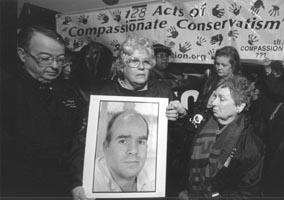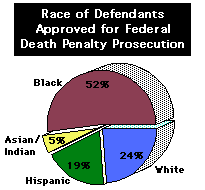Innocence Bill Introduced in Senate
Illinois Congressman Jesse Jackson, Jr. introduced HR 3623, “The Accuracy In Judicial Administration Act of 2000” (AJA), on February 10. The AJA would impose a minimum 7-year national moratorium on all U.S. executions until all inmates currently sitting on death row have an opportunity to explore potentially exculpatory DNA and similar evidence.
Since 1973, 86 death row prisoners nationwide have been found to be innocent – at least eight as a result of DNA evidence. These prisoners spent an average of seven years on death row before proving their innocence. Meanwhile, the time between the average capital conviction and execution is eight years. Given drastic new restrictions on prisoner appeals resulting from the Congress’ 1996 Anti-Terrorism and Effective Death Penalty Act (AEDPA) and similar state legislation, this timeframe is only expected to shorten. Hence, the AJA sets a seven-year moratorium to insure that prisoners will not be executed before they have a chance to prove their innocence.
Representatives Chaka Fattah (D-PA), Jan Schakowsky (D-IL), Gregory Meeks (D-NY), Bill Clay (D-MO), Tom Barrett (D-WI), and Delegate Eleanor Holmes Norton (D-DC) joined Congressman Jackson as original co-sponsors of HR 3623. The bill is currently in the hands of the House Judiciary Committee, which will determine whether or not to hold hearings.
Jackson represents the 2nd Congressional District of Illinois, home to the infamous “Ford Height Four” – four wrongly convicted young men, two of whom spent a decade on death row. Their innocence was discovered as a result of DNA testing.
“Innocence Protection Act” Introduced in Senate
On the other side of the U.S. Capitol, Senator Patrick Leahy (D-VT) introduced the “Innocence Protection Act” (IPA) on February 11. This legislation aims to reduce the risk of executing innocent persons by ensuring that state and federal prisoners have access to DNA testing. The bill also begins to remedy disparities in the administration of the death penalty that underlie the growing national call for a moratorium, including the inadequate legal counsel suffered by the vast majority of capital defendants.
DNA Evidence
DNA testing has only become commonplace in pre-trial investigations since 1994. It clearly helps prevent wrongful convictions. A 1996 Department of Justice report found that in approximately 20–30% of cases referred for DNA testing, the results excluded the primary suspect.
Many death row prisoners have never had access to DNA testing, either pre-trial or post-conviction. Yet, new techniques make it possible to analyze minute evidence samples previously untestable. Unlike all other evidence, DNA does not become less reliable over time. Only two states, New York and Illinois, have laws that provide for post-conviction DNA testing.
The first step in making this testing available to prisoners is to insure that biological evidence is preserved. Since 1992, the Innocence Project at the Cardozo School of Law has received thousands of letters from prisoners who claim that DNA testing could prove them innocent. In over 70% of these cases, where DNA testing might have demonstrated innocence, the evidence had been destroyed or lost. Further, in two-thirds of the cases where the evidence was found and DNA testing was conducted, the results exonerated the prisoner.
Leahy’s bill will prohibit the federal government from destroying any biological material in a criminal case while any person remains incarcerated in connection with that case, unless this prisoner is officially notified and given at least 90 days to request DNA testing. Further, states receiving federal grants for DNA related programs – totaling $50 million since 1994 – will be required to adopt adequate procedures for preserving biological material and making DNA testing available to their prisoners.
Additionally, the IPA would establish rules and procedures governing applications for DNA testing from federal prisoners. It also prohibits a state from denying prisoners’ requests for DNA testing that could exonerate them. Some states have refused DNA testing to prisoners with compelling questions of innocence, as in the case of Joseph O’Dell, executed in Virginia in 1997.
Competent Legal Counsel
The American Bar Association has concluded that the “decisions about who will live and who will die turn not on the nature of the offense the defendant is charged with committing, but rather on the nature of the legal representation the defendant receives.” It is on a state level that the vast majority of prisoners are sentenced to death. The IPA would require any state receiving federal criminal justice grants to establish and maintain an “effective system” for providing competent legal services to indigent defendants from pre-trial proceedings through the appeals process. This part of the bill is especially critical given that many death row prisoners currently have no lawyers to pursue their appeals.
The Director of the Administrative Office of the United States Courts, in consultation with the ABA and others, would be charged with specifying the elements of an “effective system.” This system must include a centralized and independent authority for appointing lawyers in capital cases as well as adequate
compensation and reimbursement of these attorneys.
Historically, state prisoners could readily appeal their convictions and sentences in federal courts. But in 1996, Congress changed the law, requiring federal judges to basically assume that state court decisions were correct, except in rare cases. The IPA would override these 1996 barriers for capital prisoners in states which fail to provide adequate legal services. It also increases federal funds available to public agencies and non-profit organizations that provide legal representation in capital cases and encourages that the same lawyers handle both state and federal appeals.
Finally, the IPA increases the amount unjustly imprisoned people in the federal system can be awarded by the courts from $5,000 to $50,000 a year in non-death penalty cases and to $100,000 a year in death penalty cases. It also limits the ability of the federal government’s authority to impose the death penalty in jurisdictions that do not have the death penalty.



